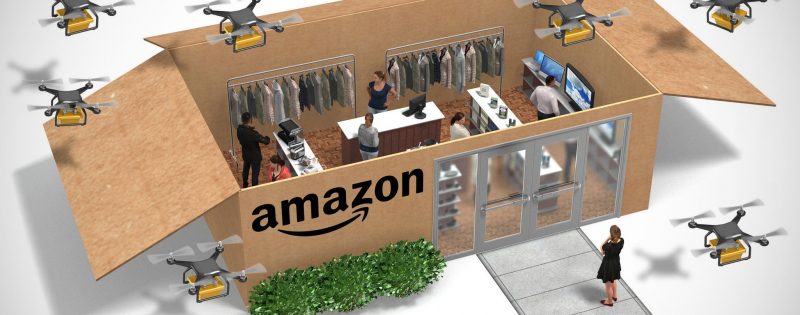
Retail in the Age of Amazon
January 18, 2018 | Posted in: Business, Commercial Real Estate, Real Estate, Technology
Even if you are not a Wall Street analyst, you are probably well-informed about Amazon’s recent accomplishments. The company has come a long way from its humble book-vendor beginning, as it is now inches away from owning (some would say monopolizing) the modern consumer experience much in the same way Sears owned the consumer experience in the post-war era.
Amazon has become so massive that antitrust policy-makers are starting to question its reach; it has all but become common practice for competing firms to refuse entering sectors where Amazon is a “dominant player,” according to researchers at think-tank New America, and the number of these already-dominated markets is growing. Amazon’s market behavior defies precedent, as its purchase of Whole Foods increased its stock price by 3% just an hour after the announcement, violating the effect accounting inefficiencies, transaction costs and corporate infighting usually have on investors’ typical perceptions of stock value — this effectively allowed Amazon to acquire Whole Foods for free! The company even has many major American cities desperately vying for spots in the HQ2 location vetting process — Dallas included.
In addition to the Whole Foods acquisition, 2017 has witnessed additional Amazon innovations that further its reach into the retail landscape including launching Amazon Echo and introducing dash buttons that make ordering products from its website dangerously convenient. These initiatives can perhaps be interpreted as moves to capitalize in physical markets, as the company’s ubiquity in the digital realm is unquestioned and has, perhaps, reached its limit. Certainly, consumers have little reason to turn anywhere except an Amazon entity when shopping for anything. Amazon’s website provides an endless list of consumer items and the addition of Whole Foods now enables Amazon to cover the perishable groceries. What reason do American consumers have for shopping elsewhere?
It is not always obvious, but brick-and-mortar stores still have the capacity to offer shoppers an experience and venue for entertainment that Amazon cannot rival. However, I doubt most people would classify an excursion to the nearest strip mall as an experience worth the effort involved in leaving the home — no doubt the reason why many of the unattractive variety were built before online shopping took off in earnest. While Amazon has not eradicated the viability of physical stores quite yet, its success has raised the stakes and standards for retail architecture and urban design, as boring and insipid shopping experiences will die as consumer acceptance of Amazon dash buttons increases.
Shopping must be an aesthetic and entertaining experience in addition to a transactional one. As much of the American demographic that Amazon (and Whole Foods) targets are suburbanites who long for an urban experience without the associated problems — congestion, poor schools, crime — shopping centers that offer urban walkability, multiple levels, apartment living and an interesting streetscape are wildly successful. Think Lincoln Road in South Beach, Santana Row in San Jose, the 3rd Street Promenade in Santa Monica and now Dallas Midtown in Dallas, of course! These New Urbanist / Mixed Use / “Surban” developments represent the future of physical American retail under the digital hegemony of Amazon.
The attractions of new urbanist development are not strictly divorced from tech advancements either; technology and bricks-and-mortar stores can benefit from each other. Look no further than last year’s Pokémon Go phenomenon for evidence in support my point. Augmented reality (“AR”), which overlays a digital image on the physical world, perhaps is not an obvious motivator for better urban design, but urban landscapes with more variety are more interesting for AR software developers. For example, in the peak of the Pokémon Go frenzy last summer, the Shops of Legacy in Plano was littered with gamers wandering its central fountain in search of new virtual pokémon to capture. As Facebook contemplates launching its own AR initiative, real estate professionals should take note.
Although Amazon currently seems like a juggernaut in the American shopping experience, it may not rule with such dominance forever Once itself a juggernaut, Sears, perhaps Amazon’s closest peer in terms of business model and significance in American retail history, has closed 72 stores in 2017 and continues to underperform in its markets after its historic run throughout most of the 20th century. It remains to be seen whether Amazon will jump the inevitable S-curve that Sears missed. As a real estate developer, I believe there will always be a need for a physical shopping presence and, accordingly, investment in good urban design is critical if these developments are to be successful. As dash buttons and Whole Foods’ almond butter appear to have won the day and become even more ubiquitous, creating physical experiences will be of paramount importance for real estate owners and investors. As the shape of retail changes it will be exciting to see how Amazon HQ2 integrates into its new home. In Dallas, we are all excited to be selected as one of the top 20 finalists.
Scott N. Beck
Scott N. Beck, a Dallas Texas Greenhill alumni, received a Masters of Accounting from the McCombs School of Business at the University of Texas at Austin where he completed his B.B.A. Mr. Beck is a member of the Board of Directors of United Texas Bank and is President of Beck Ventures.
3 Comments
Leave a Reply to Wanda Woroszylo Cancel reply
*

Tom Heraty
January 19, 2018
Great article Scott.
Maggie
January 21, 2018
Thumbs up! As a resident of the wider Midtown area, I can’t wait to see some progress in the former Valley View Center area. When?
Wanda Woroszylo
January 22, 2018
Fantastic article Scott